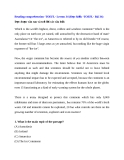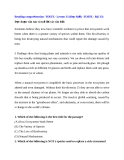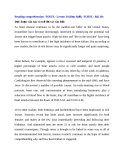
Reading comprehension -TOEFL- Lesson 16 (Đ c hi u -TOEFL- Bài 16)ọ ể
Đ c đo n văn sau và tr l i các câu h i:ọ ạ ả ờ ỏ
About 200 million years ago, as the Triassic Period came to a close, many species
of animals disappeared from the face of the Earth. Scientists previously believed
that the series of extinctions happened over a period of 15 to 20 million years.
Recent discoveries in Nova Scotia 5 suggest, however, that the extinctions may
have happened over a much shorter period of time, perhaps less than 850,000
years.
Evidence for a rapid extinction of species at the end of the Triassic Period is found
in the McCoy Brook Formation along the Bay of Fundy 10 in Nova Scotia. Fossils
found in this formation indicate a rapid disappearance of species rather than a slow
and gradual change over time. One explanation for a relatively sudden extinction at
the end of the Triassic may be that a large meteorite struck the earth at the time and
is responsible for a 70- kilometer hole nearby. If geologists 15 and other
researchers can find evidence, such as shocked quartz in the rock formations, that a
meteorite did strike the earth, it would give more credence to the theory of rapid
Triassic extinctions. It is possible, however, that even if a rapid extinction
happened in and around Nova Scotia, it did not necessarily occur in the rest 20 of
the world.
1. What is the main topic of this passage?
(A) the disappearance of animal species at the end of the Triassic Period
(B) evidence of a relatively sudden extinction of species
(C) the possibility of an extinction happening simultaneously throughout the world
(D) a meteorite hole in the Bay of Fundy in Nova Scotia

2. Which of the following could best replace the word "close" as used in line
1?
(A) connection
(B) dispersion
(C) separation
(D) end
3. The author uses the phrase "the face of the Earth" in line 2 in order to
(A) emphasize the disappearance
(B) focus on one part of the Earth
(C) focus on one period of time
(D) point out the reference to land, not water
4. All of the following were mentioned in the passage EXCEPT
(A) the extinction of late Triassic animals
(B) the duration of time for the extinction
(C) a large meteorite hitting the Earth 10 million years ago
(D) the use of types of rock in scientific research
5. Which of the following is closest in meaning to the word "relatively" in line
12?
(A) comparatively
(B) independently
(C) phenomenally
(D) visibly
6. Where in the passage does the author give evidence for the argument?
(A) Lines 1-4
(B) Lines 8-12
(C) Lines 12-17
(D) Lines 17-20

7. According to the passage, what would give evidence that a meteorite struck
the earth?
(A) a gradual change in species over time
(B) a change in the quartz
(C) gold deposits in the veins of rocks
(D) a change in the waters of the Bay of Fundy
8. Which of the following could best replace the word "struck" as used in line
13?
(A) affected
(B) discovered
(C) devastated
(D) hit
9. Which of the following is most probably the meaning of "shocked quartz"
in line 15?
(A) narrow chasms
(B) tiny lines
(C) hardened ores
(D) cracked minerals
10. In line 16, "it" refers to
(A) evidence
(B) an extinction
(C) the Earth
(D) a meteorite
11. Which of the following could best replace the word "credence" in line 17?
(A) demonstration
(B) elevation
(C) suitability

(D) credibility
12. Which of the following best describes the author's tone?
(A) aggressive
(B) explanatory
(C) apologetic
(D) cynical













![Tài liệu luyện thi TOEIC cấp tốc trong 10 ngày [chuẩn nhất]](https://cdn.tailieu.vn/images/document/thumbnail/2025/20251029/kimphuong1001/135x160/99661761725822.jpg)
![Tài liệu Phá đảo TOEIC 900+ từ mất gốc trong 30 ngày [Mới nhất]](https://cdn.tailieu.vn/images/document/thumbnail/2025/20251029/kimphuong1001/135x160/2101761720956.jpg)











